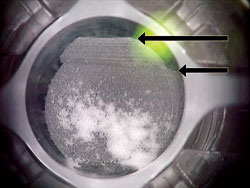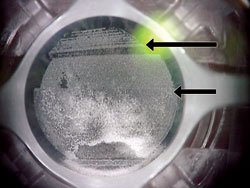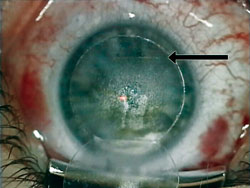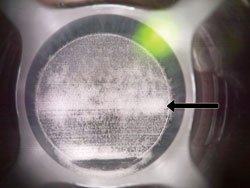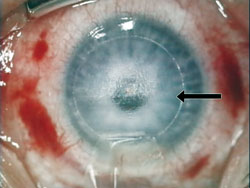Femtosecond LASIK flap creation yields low intraoperative complication rate
The system’s onboard computer allows the laser to re-dock and re-treat when suction loss occurs, enabling correction during the same surgical session.
Intraoperative complications related to femtosecond LASIK flap creation were infrequent and amenable to fast, easy correction, a large study found.
The authors reported the incidence and management of complications that occurred during LASIK flap creation with the IntraLase FS femtosecond laser (Abbott Medical Optics).
“The whole point of the paper was that you can do a fairly large number of cases and not have complications that damage the eye in a permanent way,” James A. Davison, MD, FACS, the corresponding author, told Ocular Surgery News in an interview. The authors attributed the low complication rate to the precision of femtosecond laser technology, rigorous staff training and proper patient handling.
“If you can reduce risk by having superior technology, well-trained staff and controlled conditions, you just need to do that,” he said.
Dr. Davison noted that flap creation with mechanical microkeratomes is suitable in some cases.
“I respect those who use a mechanical keratome,” he said. “It is just that the femtosecond laser works for our practice.”
Flap diameter and thickness
The prospective study included 3,009 eyes that underwent LASIK with femtosecond laser flap creation between 2002 and 2009.
The procedures were performed amid a series of updates and improvements to the IntraLase platform, such as increases in the rate of pulse delivery. These improvements reduced treatment time to about 25 seconds.
“The computer, the machine and the laser all improved,” Dr. Davison said. Whereas these technical aspects changed over time, the technique did not.
Two excimer lasers were used to perform ablation: first the Technolas 217z (Bausch + Lomb) and later the Allegretto Wave Eye-Q (Alcon). Recommended flap diameter was 8.5 mm for the Technolas and 9 mm for the Allegretto.
|
|
|
|
|
(Left) Laser energy continued to be delivered
for 2 seconds from the moment of suction loss (short arrow) to the moment of
foot pedal release (long arrow). After suction loss, the globe shifted
slightly, leading to a discontinuity in the edge of the raster pattern. A
slightly less dense, more linear pattern opaque bubble layer is present after
suction release and decreased pressure on the cornea. (Center) As seen by more
generated opaque bubble layers, the second pass raster pattern has progressed
to the center of the visual axis (short arrow). The opaque bubble layer from
the first pass has partially dissipated in the inferior cornea and in the area
treated after suction break (long arrow). (Right) A junctional irregularity
(arrow) is visible in the inferior stromal bed where the raster pattern was
interrupted at the point of lost suction.
Images: Davison JA |
||
|
|
|
|
(Image on left) An increase in opaque bubble
layer (arrow) is visible at the junction where the second raster pass went
through the border of the interrupted first raster pass. (Image on right) A
horizontal junction (arrow) exists between the appearance of the twice treated
superior stromal bed and once treated inferior bed. |
|
Dr. Davison said that flap diameter is not a major factor in anatomic outcomes.
“You can argue for a large flap or a small flap. I think it’s a detail that is probably not significant,” he said.
Surgical protocol called for a flap thickness of 130 µm, which could be reduced to 110 µm or 120 µm to maintain a stromal bed thickness of 275 µm to 300 µm. Less than 43% of total corneal thickness was dedicated to flap creation and excimer laser treatment. The program allowed optical zones up to 6.5 mm.
“Mathematically, it works out to give a substantial, adequate flap that behaves well, that does not wrinkle or is not too thin if you want to raise it for an enhancement. It also lets you maximize the excimer laser treatment to give the best visual results,” Dr. Davison said.
Suction breaks and irregular flaps
Study data showed that 11 eyes (0.37%) had complications during flap creation: eight suction breaks, one incomplete flap and two adherent flaps.
Seven suction breaks were corrected by reapplying the laser and one was corrected by completing the side cut via surgical dissection. Incomplete flaps were corrected with surgical dissection. Adherent flaps were treated with reapplied laser energy and surgical dissection. Figures 1 and 2 show the procedure progression in one case.
The surgeon was able to resolve suction breaks during the same surgical session because the IntraLase is able to re-dock and re-treat in the same plane and with the same perimeter when suction loss occurs, Dr. Davison said.
“If computer-driven lasers have problems, they stop,” he said. “These machines are designed to just stop. They don’t operate poorly or partially. They just stop. Then you can come back and finish the surgery if that were to happen. It is just risk minimization. That allows us to kind of plug in and be good surgeons.”
The data showed that all procedures yielded normal anticipated postoperative uncorrected and corrected visual acuity. There were no postoperative complications and no cases required re-treatment. – by Matt Hasson
Reference:
- Davison JA, Johnson SC. Intraoperative complications of LASIK flaps using the IntraLase femtosecond laser in 3009 cases. J Refract Surg. 2010;26(11):851-857.
- James A. Davison, MD, FACS, can be reached at 309 E. Church St., Marshalltown, IA 50158; 641-754-6200; e-mail: jdavison@wolfeclinic.com.
- Disclosure: Dr. Davison is a paid consultant for Alcon.

